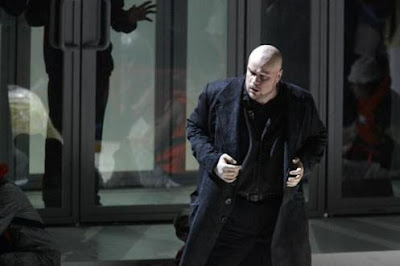With City Opera Mum on Season, Ensemble Protests.
Protests by members of the New York City Opera orchestra continued today, with a protest and impromptu concert by members of the opera company's orchestra on the shiny new steps of Lincoln Center Plaza.
This is the latest development in a long saga that started in April when the City Opera announced that they would be leaving 20 Lincoln Center for the 2011-2012 season. The company has been resident in that hall since the opening of Lincoln Center in 1966.
The musicians, led by a five-piece brass band playing excerpts from great operas, are protesting the company's decision to vacate their longstanding home at the former New York State Theater, and perform a severely truncated "wildcat" season of just five (unnanounced) operas at various (unnanounced) locations around New York City.
Watch the City Opera Orchestra play the prelude to Carmen.
This non-schedule of non-repertory in non-theaters has proved a challenge for this once-solvent company. City Opera is currently in the middle of a "Chairman's Challenge" fund-raising drive so they can actually have a season next year. Of course, with nothing to sell, it may be tough for the company's doughty phone bank workers to raise money of any kind, especially in a tough economy mired in the midst of a recession.
At a recent meeting with management, the musician's union and the union that represents singers and choristers who perform at City Opera staged a vote of "no confidence" in the leadership of City Opera GM George Steel. Despite the company's bankrupt state, Mr. Steel pulls down an annual salary of over $400,000.
Mr. Steel's two year administration has been rocked by controversial programming decisions. Despite some fiscal and critical success two years ago, the 2010-2011 season was a recipe for disaster. Obscure operas by Richard Strauss and Leonard Bernstein vied for space with experimental monodramas and a new work by Broadway composer Stephen Schwartz. This last, Seánce on a Wet Afternoon tanked with critics and failed to attract popular interest, possibly due to a murky, confusing marketing campaign that alienated opera lovers without drawing a new audience.
In other news, City Opera board member and acclaimed mezzo-soprano Joyce Castle has announced her decision to resign from the City Opera board. You can read her letter (dated June 23) here.
Protests by members of the New York City Opera orchestra continued today, with a protest and impromptu concert by members of the opera company's orchestra on the shiny new steps of Lincoln Center Plaza.
 |
| The City Opera's latest union negotiating tool. |
The musicians, led by a five-piece brass band playing excerpts from great operas, are protesting the company's decision to vacate their longstanding home at the former New York State Theater, and perform a severely truncated "wildcat" season of just five (unnanounced) operas at various (unnanounced) locations around New York City.
This non-schedule of non-repertory in non-theaters has proved a challenge for this once-solvent company. City Opera is currently in the middle of a "Chairman's Challenge" fund-raising drive so they can actually have a season next year. Of course, with nothing to sell, it may be tough for the company's doughty phone bank workers to raise money of any kind, especially in a tough economy mired in the midst of a recession.
 |
| And the musicians' equivalent. |
Mr. Steel's two year administration has been rocked by controversial programming decisions. Despite some fiscal and critical success two years ago, the 2010-2011 season was a recipe for disaster. Obscure operas by Richard Strauss and Leonard Bernstein vied for space with experimental monodramas and a new work by Broadway composer Stephen Schwartz. This last, Seánce on a Wet Afternoon tanked with critics and failed to attract popular interest, possibly due to a murky, confusing marketing campaign that alienated opera lovers without drawing a new audience.
In other news, City Opera board member and acclaimed mezzo-soprano Joyce Castle has announced her decision to resign from the City Opera board. You can read her letter (dated June 23) here.















